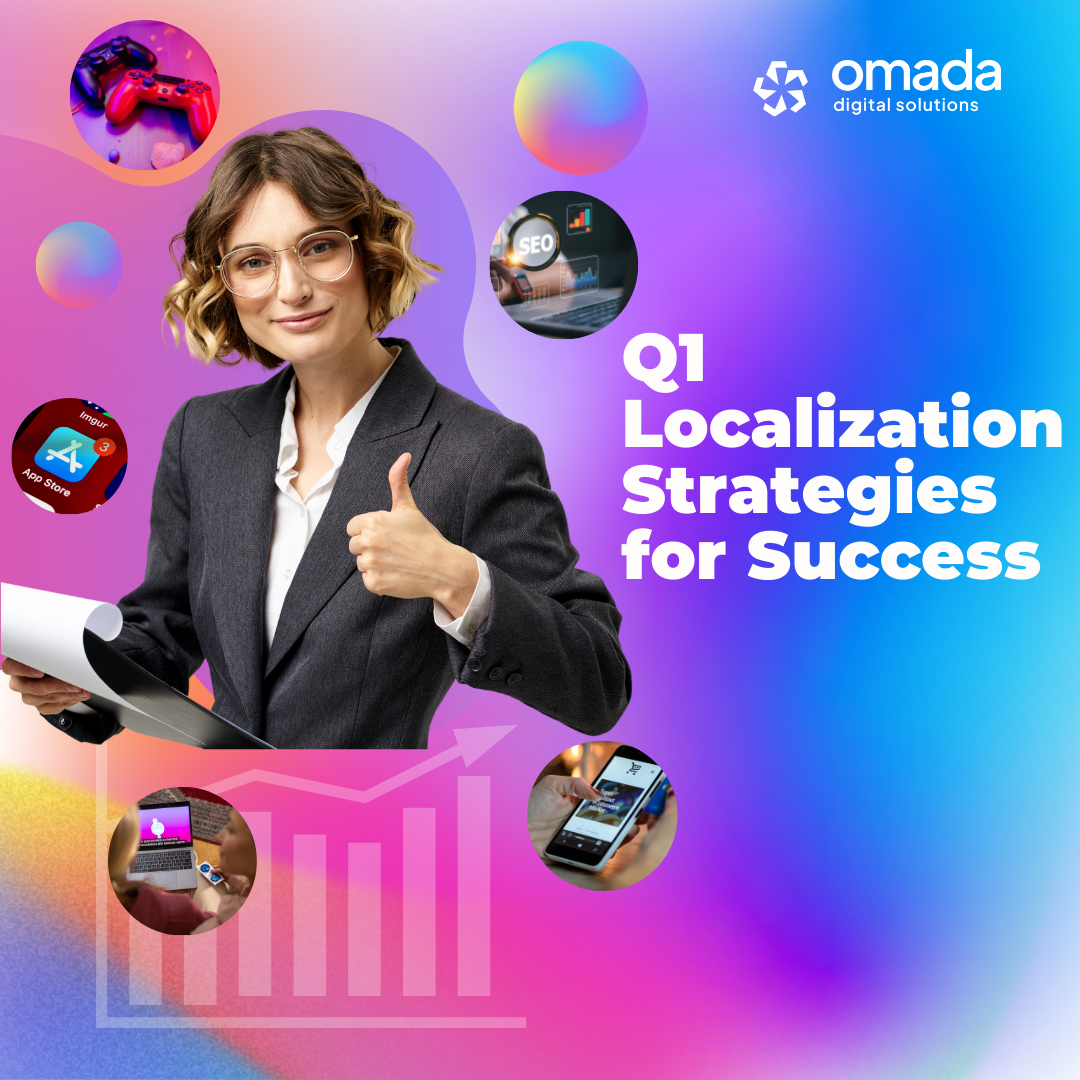
Ah, the fresh start of Q1! It’s that time when we shake off the old and dive into the new, especially in the ever-evolving realm of localization. Last year was a wild ride, and 2023’s trends have given us a goldmine of insights. Ready to up your localization game this year? Let’s unwrap these gems and get your year rolling with a bang!
In the dynamic field of localization, it’s a time of excitement yet overwhelming with new objectives and methodologies to implement. It’s crucial to be flexible and ready to adapt quickly. To assist you in your efforts, we have compiled for you 7 data-driven localization strategies for excelling in Q1, along with your benefits from using each one of them. Let’s dive in!
1. AI: The New Localization Maverick
Hey there, AI revolution! Last year was all about AI transforming how we tackle translations. Faster, smarter, culturally on-point – AI-powered localization platforms became the new best friends for localization pros. It’s not just about translating words; it’s about nailing the context, the culture, the whole vibe of your target market. AI’s got this in spades!
Working with AI-powered localization platforms offers several benefits:
- Efficiency and Speed: AI tools can translate large volumes of text quickly, significantly reducing turnaround time.
- Cost-Effectiveness: These tools often lower translation costs compared to entirely manual translation processes.
- Consistency: AI-powered tools maintain consistent use of terminology and style across multiple documents.
- Scalability: They can handle increasing volumes of work without a proportional increase in cost or time.
- Language Diversity: AI tools can translate a wide range of languages, broadening the potential market reach.
- Improved Accuracy: With advancements in AI, the accuracy of machine translations has significantly improved, though human oversight is still crucial for nuanced texts.
- Real-Time Translation: Some AI tools offer real-time translation, useful for instant communication across language barriers.
2. The Mobile App Localization Wave
Catch this wave! Mobile app markets are booming, and if you’re not localizing your apps, you’re missing out big time. 2023 showed us the power of reaching users in their language, on their devices. It’s not just about being understood; it’s about being relatable, accessible, and yes, downloadable.
Mobile app localization is crucial for global expansion due to several benefits:
- Broader Reach: Localizing your app makes it accessible to a larger, global audience.
- Increased Downloads: Users are more likely to download apps in their native language.
- Improved User Experience: Localization enhances the user experience by adapting the app to local languages and cultures.
- Competitive Advantage: It gives an edge over competitors who have not localized their apps.
- Higher Engagement and Retention: Users engage more with content in their native language, leading to better retention rates.
- Revenue Growth: Localization can lead to increased revenue, as users are more willing to make in-app purchases in their own language.
3. E-commerce Localization: Speak My Language, Boost My Sales
Talk the talk of your global customers. E-commerce sites that got chatty in their customers’ languages saw their engagement and sales skyrocket. We’re talking tailored content, local currencies, and payment methods that scream, “We get you!”
E-commerce localization is essential for global expansion, offering several benefits:
- Enhanced User Experience: Tailoring the shopping experience to local languages and cultures improves user engagement.
- Increased Sales: Customers are more likely to purchase from a website that speaks their language and understands their cultural context.
- Market Penetration: Localization helps in effectively entering and establishing a presence in new international markets.
- Brand Trust: A localized e-commerce site builds trust with local customers, as it demonstrates commitment to their needs and preferences.
- Competitive Advantage: It differentiates your brand in crowded markets, offering a unique customer experience.
- SEO Optimization: Localized content can improve search engine rankings in different regions, driving more organic traffic.
4. Video Content: Subtitle Me, Dub Me, Love Me
Video is king, and localization is its crown. The demand for video content that speaks everyone’s language went through the roof. Subtitles, dubbing, local flavors – it’s all about connecting with your audience in a way that resonates.
Video localization is key for global expansion, offering benefits like:
- Wider Audience Reach: Localized videos can attract viewers from different linguistic and cultural backgrounds.
- Increased Engagement: Content in native languages tends to engage viewers more deeply.
- Cultural Relevance: Tailoring content to local cultures enhances relatability and reduces cultural misunderstandings.
- Improved SEO: Localized videos can rank higher in search results in different regions.
- Higher Conversion Rates: Localized content often leads to better conversion and sales, as viewers feel more connected.
- Brand Globalization: It supports the brand’s image as a global player, aware and respectful of diverse cultures.
5. Gaming Localization: Play in My Language, Win My Heart
Games that talk the talk walk the walk. Gamers worldwide showed us they love playing in their language, with cultural nuances that make the experience truly theirs. It’s not just a game; it’s an experience.
Localize your SEO, and watch your traffic soar. Targeting your SEO to specific regions isn’t just smart; it’s essential. Think local keywords, content that hits home – it’s all about being where your customers are searching.
SEO Localization offers benefits like:
- Targeted Traffic: It attracts visitors from specific regions, increasing website relevance.
- Enhanced User Experience: Localized SEO provides content in the user’s native language, improving engagement.
- Increased Conversion Rates: Localized content resonates better, leading to higher conversions.
- Better Search Rankings: SEO tailored to local languages improves search visibility in targeted markets.
- Cultural Relevance: It ensures content is culturally appropriate, building trust with local audiences.
- Competitive Edge: Stands out in local markets, potentially outperforming non-localized competitors.
7. The Human Touch in AI-powered Localization
AI’s cool, but the human touch is cooler. Sure, AI’s changing the game, but let’s not forget the irreplaceable value of human insight, especially when dealing with nuanced languages and complex cultural contexts. It’s about striking that perfect balance.
For a company seeking multilingual content, human insight in AI-powered translation is invaluable as localizers and post-editors working with AI-powered tools bring:
- Cultural Understanding: Human translators grasp cultural nuances, ensuring content is culturally appropriate.
- Context Sensitivity: Humans understand the context, making translations more relevant and accurate.
- Emotional Intelligence: Humans can convey the emotional tone of content, crucial in marketing and creative materials.
- Brand Voice Consistency: Human insight maintains a consistent brand voice across languages.
- Nuanced Communication: Humans are better at interpreting and translating idioms, slang, and subtle language features.
- Quality Assurance: Human oversight corrects and refines AI translations, enhancing overall quality.
- Adaptability: Humans can adapt translations based on target audience, region, and purpose.
Essentially, while AI provides efficiency and a baseline accuracy, human expertise ensures that multilingual content is engaging, appropriate, and effective in achieving communication goals.
Our 3 Quick Q1 Localization Tips – Stay Smart, Stay Flexible
- Elastic Approach: Just like in marketing, localization strategies should be flexible. We emphasize adaptability and readiness to pivot, allowing quick responses to market shifts and consumer feedback in localization.
- Reflect on Past Performance: Before implementing new localization strategies, assess last year’s outcomes. Discard ineffective approaches to free resources for innovative ideas.
- Back to Basics: Understanding your target audience is crucial in localization. We suggest continuously exploring audience preferences and behaviors, adapting localization strategies accordingly.
Back to You
So there you have it – your playbook for starting Q1 with a localization strategy that’s as dynamic as the global markets. Keep these insights handy, stay adaptable, and remember, in the world of localization, it’s all about connecting, resonating, and making every word count.




